Khang Nguyen
DeGuV: Depth-Guided Visual Reinforcement Learning for Generalization and Interpretability in Manipulation
Sep 05, 2025Abstract:Reinforcement learning (RL) agents can learn to solve complex tasks from visual inputs, but generalizing these learned skills to new environments remains a major challenge in RL application, especially robotics. While data augmentation can improve generalization, it often compromises sample efficiency and training stability. This paper introduces DeGuV, an RL framework that enhances both generalization and sample efficiency. In specific, we leverage a learnable masker network that produces a mask from the depth input, preserving only critical visual information while discarding irrelevant pixels. Through this, we ensure that our RL agents focus on essential features, improving robustness under data augmentation. In addition, we incorporate contrastive learning and stabilize Q-value estimation under augmentation to further enhance sample efficiency and training stability. We evaluate our proposed method on the RL-ViGen benchmark using the Franka Emika robot and demonstrate its effectiveness in zero-shot sim-to-real transfer. Our results show that DeGuV outperforms state-of-the-art methods in both generalization and sample efficiency while also improving interpretability by highlighting the most relevant regions in the visual input
DoublyAware: Dual Planning and Policy Awareness for Temporal Difference Learning in Humanoid Locomotion
Jun 12, 2025Abstract:Achieving robust robot learning for humanoid locomotion is a fundamental challenge in model-based reinforcement learning (MBRL), where environmental stochasticity and randomness can hinder efficient exploration and learning stability. The environmental, so-called aleatoric, uncertainty can be amplified in high-dimensional action spaces with complex contact dynamics, and further entangled with epistemic uncertainty in the models during learning phases. In this work, we propose DoublyAware, an uncertainty-aware extension of Temporal Difference Model Predictive Control (TD-MPC) that explicitly decomposes uncertainty into two disjoint interpretable components, i.e., planning and policy uncertainties. To handle the planning uncertainty, DoublyAware employs conformal prediction to filter candidate trajectories using quantile-calibrated risk bounds, ensuring statistical consistency and robustness against stochastic dynamics. Meanwhile, policy rollouts are leveraged as structured informative priors to support the learning phase with Group-Relative Policy Constraint (GRPC) optimizers that impose a group-based adaptive trust-region in the latent action space. This principled combination enables the robot agent to prioritize high-confidence, high-reward behavior while maintaining effective, targeted exploration under uncertainty. Evaluated on the HumanoidBench locomotion suite with the Unitree 26-DoF H1-2 humanoid, DoublyAware demonstrates improved sample efficiency, accelerated convergence, and enhanced motion feasibility compared to RL baselines. Our simulation results emphasize the significance of structured uncertainty modeling for data-efficient and reliable decision-making in TD-MPC-based humanoid locomotion learning.
Lifelong Whole Slide Image Analysis: Online Vision-Language Adaptation and Past-to-Present Gradient Distillation
May 04, 2025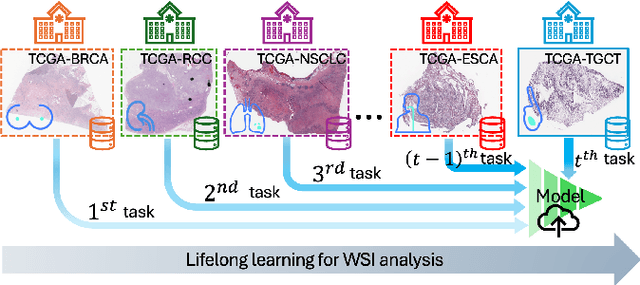
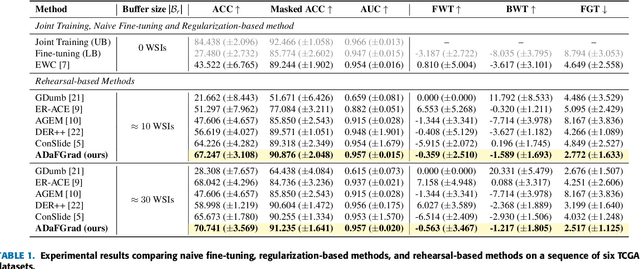
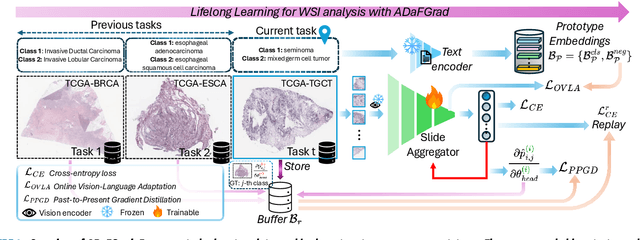
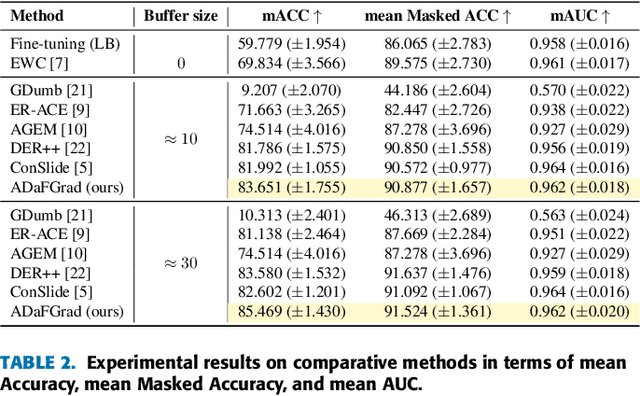
Abstract:Whole Slide Images (WSIs) play a crucial role in accurate cancer diagnosis and prognosis, as they provide tissue details at the cellular level. However, the rapid growth of computational tasks involving WSIs poses significant challenges. Given that WSIs are gigapixels in size, they present difficulties in terms of storage, processing, and model training. Therefore, it is essential to develop lifelong learning approaches for WSI analysis. In scenarios where slides are distributed across multiple institutes, we aim to leverage them to develop a unified online model as a computational tool for cancer diagnosis in clinical and hospital settings. In this study, we introduce ADaFGrad, a method designed to enhance lifelong learning for whole-slide image (WSI) analysis. First, we leverage pathology vision-language foundation models to develop a framework that enables interaction between a slide's regional tissue features and a predefined text-based prototype buffer. Additionally, we propose a gradient-distillation mechanism that mimics the gradient of a logit with respect to the classification-head parameters across past and current iterations in a continual-learning setting. We construct a sequence of six TCGA datasets for training and evaluation. Experimental results show that ADaFGrad outperforms both state-of-the-art WSI-specific and conventional continual-learning methods after only a few training epochs, exceeding them by up to +5.068% in the class-incremental learning scenario while exhibiting the least forgetting (i.e., retaining the most knowledge from previous tasks). Moreover, ADaFGrad surpasses its baseline by as much as +40.084% in accuracy, further demonstrating the effectiveness of the proposed modules.
FlowMP: Learning Motion Fields for Robot Planning with Conditional Flow Matching
Mar 08, 2025Abstract:Prior flow matching methods in robotics have primarily learned velocity fields to morph one distribution of trajectories into another. In this work, we extend flow matching to capture second-order trajectory dynamics, incorporating acceleration effects either explicitly in the model or implicitly through the learning objective. Unlike diffusion models, which rely on a noisy forward process and iterative denoising steps, flow matching trains a continuous transformation (flow) that directly maps a simple prior distribution to the target trajectory distribution without any denoising procedure. By modeling trajectories with second-order dynamics, our approach ensures that generated robot motions are smooth and physically executable, avoiding the jerky or dynamically infeasible trajectories that first-order models might produce. We empirically demonstrate that this second-order conditional flow matching yields superior performance on motion planning benchmarks, achieving smoother trajectories and higher success rates than baseline planners. These findings highlight the advantage of learning acceleration-aware motion fields, as our method outperforms existing motion planning methods in terms of trajectory quality and planning success.
Distortion-Aware Adversarial Attacks on Bounding Boxes of Object Detectors
Dec 25, 2024Abstract:Deep learning-based object detection has become ubiquitous in the last decade due to its high accuracy in many real-world applications. With this growing trend, these models are interested in being attacked by adversaries, with most of the results being on classifiers, which do not match the context of practical object detection. In this work, we propose a novel method to fool object detectors, expose the vulnerability of state-of-the-art detectors, and promote later works to build more robust detectors to adversarial examples. Our method aims to generate adversarial images by perturbing object confidence scores during training, which is crucial in predicting confidence for each class in the testing phase. Herein, we provide a more intuitive technique to embed additive noises based on detected objects' masks and the training loss with distortion control over the original image by leveraging the gradient of iterative images. To verify the proposed method, we perform adversarial attacks against different object detectors, including the most recent state-of-the-art models like YOLOv8, Faster R-CNN, RetinaNet, and Swin Transformer. We also evaluate our technique on MS COCO 2017 and PASCAL VOC 2012 datasets and analyze the trade-off between success attack rate and image distortion. Our experiments show that the achievable success attack rate is up to $100$\% and up to $98$\% when performing white-box and black-box attacks, respectively. The source code and relevant documentation for this work are available at the following link: https://github.com/anonymous20210106/attack_detector
Volumetric Mapping with Panoptic Refinement via Kernel Density Estimation for Mobile Robots
Dec 15, 2024
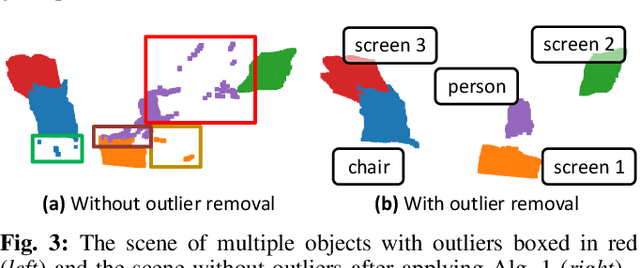


Abstract:Reconstructing three-dimensional (3D) scenes with semantic understanding is vital in many robotic applications. Robots need to identify which objects, along with their positions and shapes, to manipulate them precisely with given tasks. Mobile robots, especially, usually use lightweight networks to segment objects on RGB images and then localize them via depth maps; however, they often encounter out-of-distribution scenarios where masks over-cover the objects. In this paper, we address the problem of panoptic segmentation quality in 3D scene reconstruction by refining segmentation errors using non-parametric statistical methods. To enhance mask precision, we map the predicted masks into a depth frame to estimate their distribution via kernel densities. The outliers in depth perception are then rejected without the need for additional parameters in an adaptive manner to out-of-distribution scenarios, followed by 3D reconstruction using projective signed distance functions (SDFs). We validate our method on a synthetic dataset, which shows improvements in both quantitative and qualitative results for panoptic mapping. Through real-world testing, the results furthermore show our method's capability to be deployed on a real-robot system. Our source code is available at: https://github.com/mkhangg/refined panoptic mapping.
V3D-SLAM: Robust RGB-D SLAM in Dynamic Environments with 3D Semantic Geometry Voting
Oct 15, 2024



Abstract:Simultaneous localization and mapping (SLAM) in highly dynamic environments is challenging due to the correlation complexity between moving objects and the camera pose. Many methods have been proposed to deal with this problem; however, the moving properties of dynamic objects with a moving camera remain unclear. Therefore, to improve SLAM's performance, minimizing disruptive events of moving objects with a physical understanding of 3D shapes and dynamics of objects is needed. In this paper, we propose a robust method, V3D-SLAM, to remove moving objects via two lightweight re-evaluation stages, including identifying potentially moving and static objects using a spatial-reasoned Hough voting mechanism and refining static objects by detecting dynamic noise caused by intra-object motions using Chamfer distances as similarity measurements. Our experiment on the TUM RGB-D benchmark on dynamic sequences with ground-truth camera trajectories showed that our methods outperform the most recent state-of-the-art SLAM methods. Our source code is available at https://github.com/tuantdang/v3d-slam.
Beyond the Visible: Jointly Attending to Spectral and Spatial Dimensions with HSI-Diffusion for the FINCH Spacecraft
Jun 15, 2024Abstract:Satellite remote sensing missions have gained popularity over the past fifteen years due to their ability to cover large swaths of land at regular intervals, making them ideal for monitoring environmental trends. The FINCH mission, a 3U+ CubeSat equipped with a hyperspectral camera, aims to monitor crop residue cover in agricultural fields. Although hyperspectral imaging captures both spectral and spatial information, it is prone to various types of noise, including random noise, stripe noise, and dead pixels. Effective denoising of these images is crucial for downstream scientific tasks. Traditional methods, including hand-crafted techniques encoding strong priors, learned 2D image denoising methods applied across different hyperspectral bands, or diffusion generative models applied independently on bands, often struggle with varying noise strengths across spectral bands, leading to significant spectral distortion. This paper presents a novel approach to hyperspectral image denoising using latent diffusion models that integrate spatial and spectral information. We particularly do so by building a 3D diffusion model and presenting a 3-stage training approach on real and synthetically crafted datasets. The proposed method preserves image structure while reducing noise. Evaluations on both popular hyperspectral denoising datasets and synthetically crafted datasets for the FINCH mission demonstrate the effectiveness of this approach.
ExtPerFC: An Efficient 2D and 3D Perception Hardware-Software Framework for Mobile Cobot
Jun 08, 2023Abstract:As the reliability of the robot's perception correlates with the number of integrated sensing modalities to tackle uncertainty, a practical solution to manage these sensors from different computers, operate them simultaneously, and maintain their real-time performance on the existing robotic system with minimal effort is needed. In this work, we present an end-to-end software-hardware framework, namely ExtPerFC, that supports both conventional hardware and software components and integrates machine learning object detectors without requiring an additional dedicated graphic processor unit (GPU). We first design our framework to achieve real-time performance on the existing robotic system, guarantee configuration optimization, and concentrate on code reusability. We then mathematically model and utilize our transfer learning strategies for 2D object detection and fuse them into depth images for 3D depth estimation. Lastly, we systematically test the proposed framework on the Baxter robot with two 7-DOF arms, a four-wheel mobility base, and an Intel RealSense D435i RGB-D camera. The results show that the robot achieves real-time performance while executing other tasks (e.g., map building, localization, navigation, object detection, arm moving, and grasping) simultaneously with available hardware like Intel onboard CPUS/GPUs on distributed computers. Also, to comprehensively control, program, and monitor the robot system, we design and introduce an end-user application. The source code is available at https://github.com/tuantdang/perception_framework.
UIT-OpenViIC: A Novel Benchmark for Evaluating Image Captioning in Vietnamese
May 09, 2023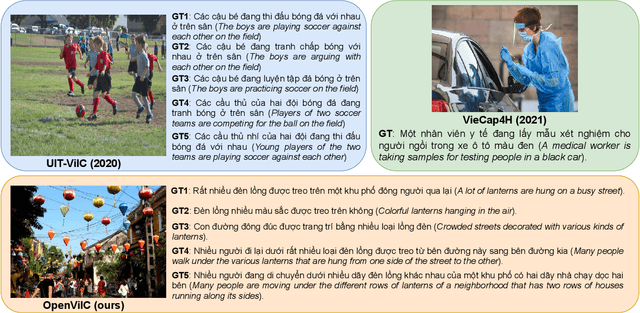
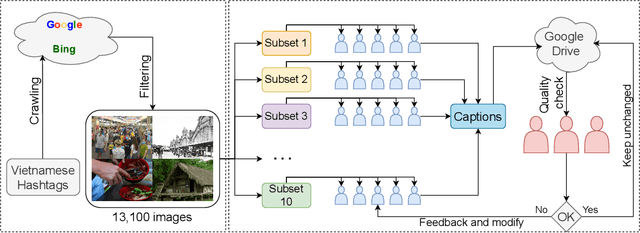
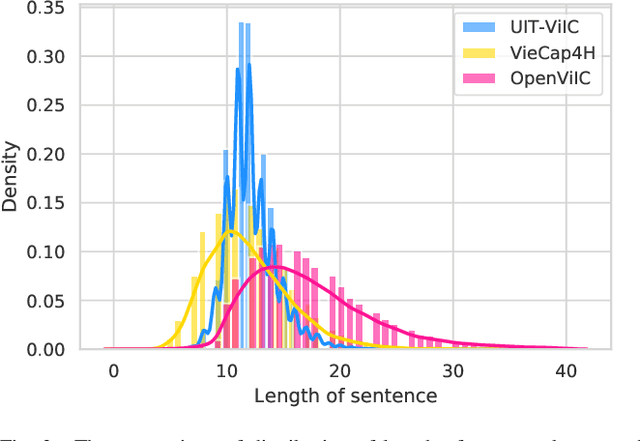

Abstract:Image Captioning is one of the vision-language tasks that still interest the research community worldwide in the 2020s. MS-COCO Caption benchmark is commonly used to evaluate the performance of advanced captioning models, although it was published in 2015. Recent captioning models trained on the MS-COCO Caption dataset only have good performance in language patterns of English; they do not have such good performance in contexts captured in Vietnam or fluently caption images using Vietnamese. To contribute to the low-resources research community as in Vietnam, we introduce a novel image captioning dataset in Vietnamese, the Open-domain Vietnamese Image Captioning dataset (UIT-OpenViIC). The introduced dataset includes complex scenes captured in Vietnam and manually annotated by Vietnamese under strict rules and supervision. In this paper, we present in more detail the dataset creation process. From preliminary analysis, we show that our dataset is challenging to recent state-of-the-art (SOTA) Transformer-based baselines, which performed well on the MS COCO dataset. Then, the modest results prove that UIT-OpenViIC has room to grow, which can be one of the standard benchmarks in Vietnamese for the research community to evaluate their captioning models. Furthermore, we present a CAMO approach that effectively enhances the image representation ability by a multi-level encoder output fusion mechanism, which helps improve the quality of generated captions compared to previous captioning models.
 Add to Chrome
Add to Chrome Add to Firefox
Add to Firefox Add to Edge
Add to Edge